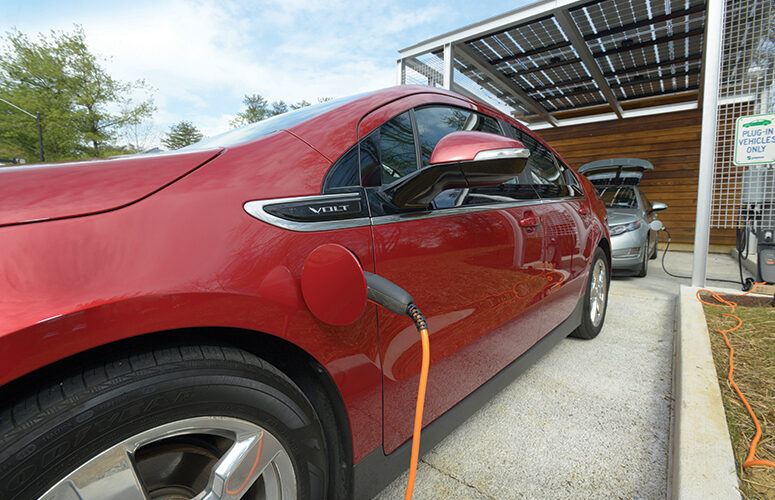
Utilities Aim for Carbon Neutrality
Discover how electric and gas utilities throughout the state are doing their best to reduce greenhouse gas emissions.
By Lisa Goulian Twiste, Contributing Writer On May 3, 2023At a press conference in mid-February, Gov. Phil Murphy made one thing perfectly clear: clean energy is a priority for his administration, and there is no time to be wasted. The state’s clean-energy target – which he announced has been fast-forwarded from 2050 to 2035 – calls for sweeping changes in the way utilities are operated and electricity is delivered to New Jersey homeowners and businesses. This includes such measures as installing zero-carbon-emission heating and cooling systems in 400,000 residences and 20,000 commercial properties by 2030 and taking steps to ensure all electricity sold in New Jersey comes from renewable sources instead of fossil fuels.
“The governor is aiming to chart the best path forward and navigate the biggest challenge we’re all trying to deal with: climate change,” says Rick Thigpen, senior vice president for corporate citizenship at PSE&G, the state’s oldest and largest public utility servicing 75% of New Jersey. “The state has its role in trying to reduce emissions; our role is to do the best we can to help our residents deal with climate change, to help those communities they live in, to help the state’s economy, and to assist in devising the best solutions to accomplish those goals.”
“Climate change is in the news every day, and it’s clear we need to minimize greenhouse gas emissions,” says Steve Westhoven, president and CEO of New Jersey Resources (NJR), the Monmouth County-based energy services holding company that serves over half a million customers in five counties through its subsidiary New Jersey Natural Gas (NJNG). “The path forward requires expertise that preserves key attributes of energy in the state: reliability, affordability, getting it there quickly, and safety.”
Three Executive Orders were signed the day of the governor’s press conference, including EO317, stating the Murphy administration will work side by side with natural gas utilities, key stakeholders such as organized labor, and the New Jersey Board of Public Utilities (BPU) to develop a plan to help the state become less reliant on fossil fuels. The governor also said he is relying on help from the Infrastructure Investment and Jobs Act of 2021, which earmarked $65 billion to upgrade the national power infrastructure and develop cutting-edge clean energy technologies.
PSE&G
Last year, PSE&G announced it would invest $511 million over four years through its Infrastructure Advancement Program (IAP) to modernize distribution systems and begin preparing the grid for the rapid transition to EVs – also part of the governor’s program. The stated goal is to enable a greater blend of renewable energy resources by making the state’s electric grid more reliable, which is expected to create hundreds of well-paying jobs and help stimulate New Jersey’s economy.
The company is also dedicated to helping customers use less energy through its Energy Efficiency Program, which includes rebates and discounts, appliance recycling, home weatherization and home energy assessments. And in early March, PSE&G filed for a three-year, $2.54 billion extension of its Gas System Modernization Program (GSMP), which will include replacing old gas mains and introducing non-fossil alternatives (renewable natural gas and hydrogen) into PSE&G’s system – especially in overburdened communities disproportionately impacted by climate change.
“There are so many important roles for utilities to play, including providing universal access to energy and making the energy world of the future more equitable than in the past,” Thigpen says.
JCP&L/First Energy
Environmental stewardship is a core value for JCP&L and its parent company, FirstEnergy, given the effects of climate change on sea surface levels and the impact of storms in the company’s service area, which is split between the barrier islands with coastal plains of the Jersey Shore and the heavily forested elevations of northern and northwestern New Jersey.
“With our dedication to continual improvement and innovation, JCP&L is poised to unlock the significant growth opportunities embedded in a decarbonized economy,” says Chris Hoenig, spokesman for JCP&L.
FirstEnergy has committed to achieving carbon neutrality by 2050 – with an interim goal of a 30% reduction in greenhouse gases in its control by 2030 (based on 2019 levels). This includes the onshore injection of offshore wind-generated electricity and the connection to the grid of the largest landfill solar site in North America, which went online in January in Mount Olive. In addition, there are projects designed to build a strong base within FirstEnergy communities, including the introduction of hybrid bucket trucks, construction of pollinator gardens, donation and planting of trees, advanced recycling programs and the sustainable growth of natural plant life in its rights-of-way.
NJ Resources
According to Westhoven, sustainability has been part of NJR’s DNA for several years, driving its utility, NJNG, to be an active participant in New Jersey communities and make business decisions based on how it impacts the environment. The company, whose goal is to reach net zero emissions from its New Jersey operations by 2050, has been proactive in solar energy since 2010, investing $1.5 billion in that space. And in late 2021, NJR placed its green hydrogen blending project into service in Howell Township, making the gas utility operator the first on the East Coast to blend this zero-carbon fuel into its distribution system.
“Our headquarters is on the Jersey Shore, and being along the shoreline, we have a unique view of the impact climate change will have on our customers,” Westhoven says. “Energy services are important for the state, for the economy. We can reach our goals while still being affordable, providing reliability to customers, and doing it quickly and safely.”
Along these lines, NJR believes using existing gas pipelines to deliver cleaner fuels is a more affordable and less disruptive path to reduce carbon emissions for customers.
South Jersey Industries
Folsom-based South Jersey Industries (SJI), which has more than 700,000 residential and commercial customers, aims to achieve carbon neutrality by 2040 by focusing on initiatives that reduce energy consumption and emissions, accelerate the deployment of renewable energy, educate customers on energy efficiency, and modernize operations. SJI’s efforts include infrastructure replacement programs designed to decrease distribution system-related CO2-equivalent emissions by about 80% at SJI’s two utilities by 2025, as well as investing in renewable energy technologies such as solar, fuel cells, green hydrogen and renewable natural gas (RNG).
The company expanded its energy efficiency programs by $216 million in 2021 so customers have greater access to rebates, financing, home energy audits, a high-efficiency products marketplace, and a residential weatherization program.
“Our customers are receiving natural gas, but we are well-positioned to transition to mixtures of RNG and hydrogen as those technologies advance,” says Mike Renna, SJI’s president & CEO. “We are actively developing renewable fuels to help make gas energy one of the safest, cleanest, most reliable, and most affordable forms of energy now and in the future.”
Atlantic City Electric
To do its part in helping meet the goals of New Jersey’s Energy Master Plan, Atlantic City Electric (ACE) has made a major climate change commitment with the goal of achieving net-zero emissions for its operations by 2050. The utility is on track to achieve its own greenhouse gas reduction goals by investing in electric vehicles, improving energy efficiency at its facilities, and reducing the loss of Sulfur Hexafluoride from gas-insulated electrical equipment. At the same time, the company is supporting the clean energy transition for its South Jersey-based customers and communities.
“Our EVsmart program provides rebates and incentives to support customers in their transition to electric vehicles, and our suite of award-winning energy efficiency programs help residential and commercial customers save money and energy,” says Doug Mokoid, ACE region president.
Plans also include installation of smart meters for the utility’s approximately 560,000 customers as part of the Smart Energy Network initiative and an improved platform to facilitate customer access to energy-efficiency programs, electric vehicles and solar. Regarding the latter, the company has helped nearly 50,000 customers connect their solar PV systems with the local energy grid, while expanding opportunities for even more solar connection across South Jersey through its Powering the Future infrastructure investment program.
Mokoid adds, “We are also supporting the state’s vision to become the wind hub of the East Coast through our Wind Port Power Connect project, upgrading key transmission lines to support the Wind Port and Paulsboro Marine Terminal, and making critical upgrades to our system to support bringing wind energy ashore.”
Looking to the future
New Jersey utilities are also taking advantage of both federal and state funding and programs to make the transition to clean energy as seamless as possible.
In addition to the 2021 Infrastructure Investment and Jobs Act, which appropriated $8 billion for “clean hydrogen hubs” around the country, the federal Inflation Reduction Act, passed last year, provides investment tax credits for biogas projects – another term for RNG – and expanded tax incentives for hydrogen investments. At the state level, pending legislation (Senate Bill No. 1366 and Assembly Bill No. 577) would help New Jersey utilities capture methane, a powerful greenhouse gas, and repurpose it for use within the existing gas system.
At the same time, the Murphy administration’s clean-energy agenda has come under increasing scrutiny. Some officials, including Ray Cantor, deputy chief government affairs officer of the New Jersey Business & Industry Association, question what accelerating the state’s clean energy program will actually cost – and whether it’s even feasible.
Yet New Jersey utilities maintain they are committed to the effort.
“Embracing proper environmental stewardship is at the core of our community-centric values, as is our commitment to enhancing the quality of life for our customers by delivering affordable, safe, and reliable energy services,” SJI’s Renna says. “We recognize we hold a shared responsibility to protect the environment we call home. That’s why we are committed to promoting sustainability, driving innovation, and leading the way toward a clean energy future for our state and region.”
To access more business news, visit NJB News Now.
Related Articles:





